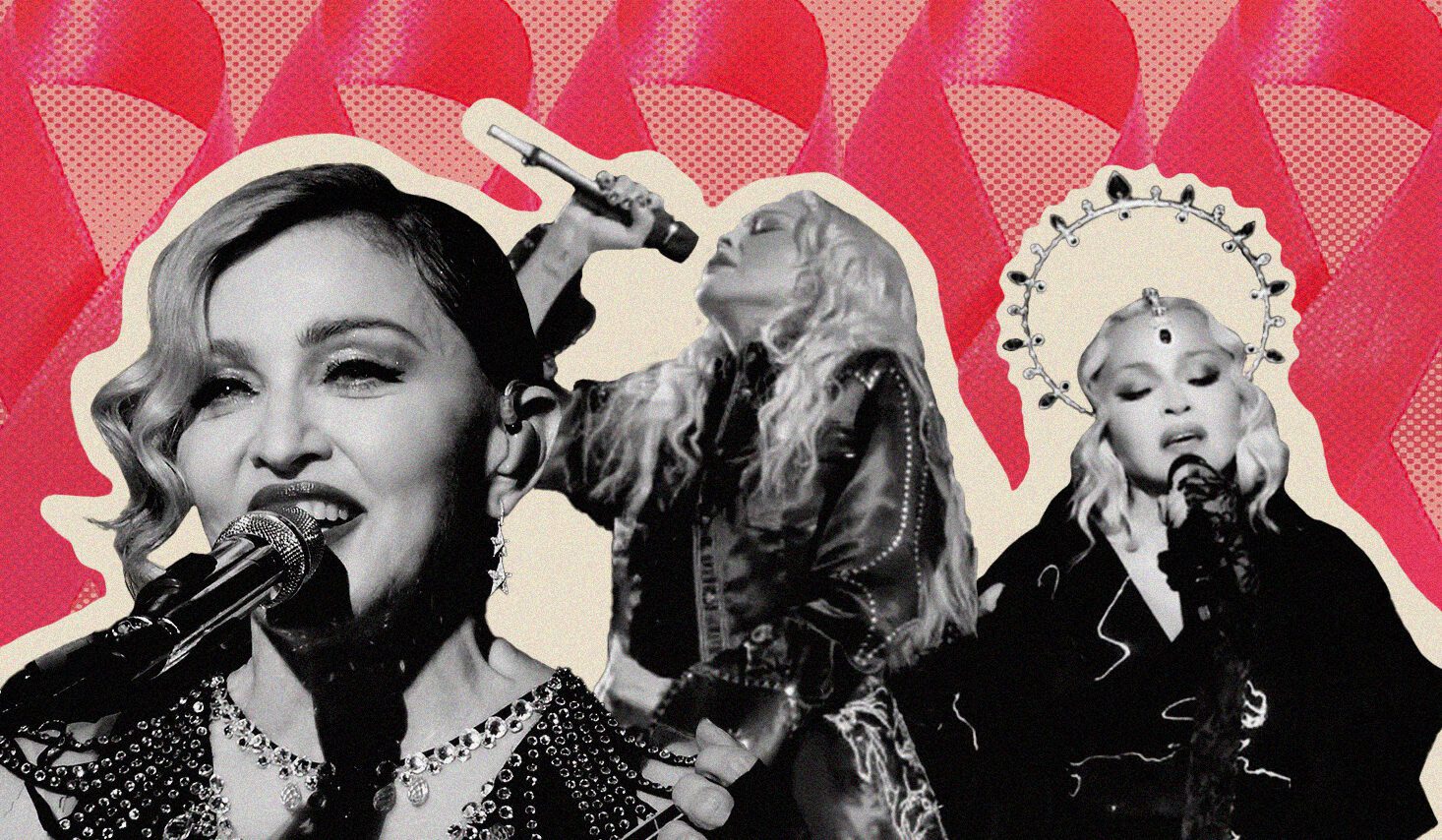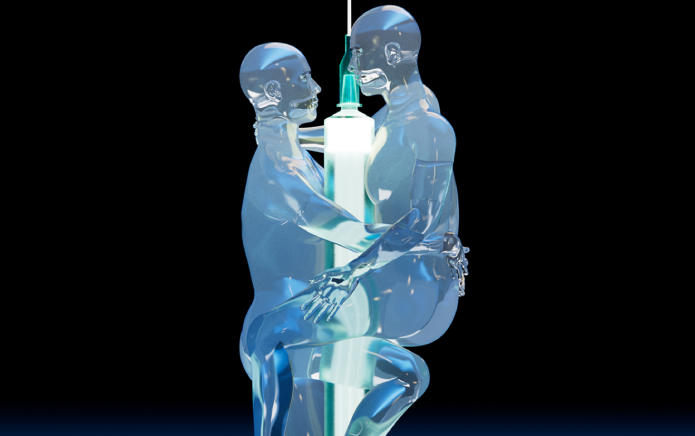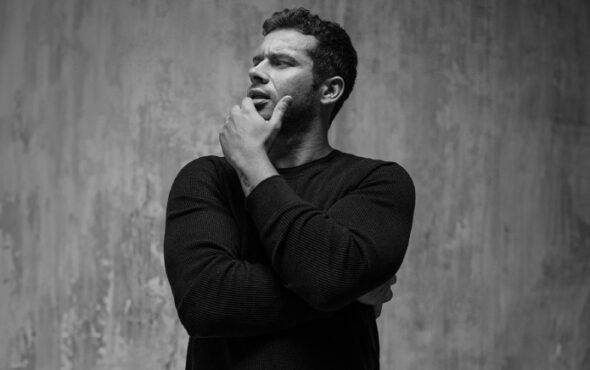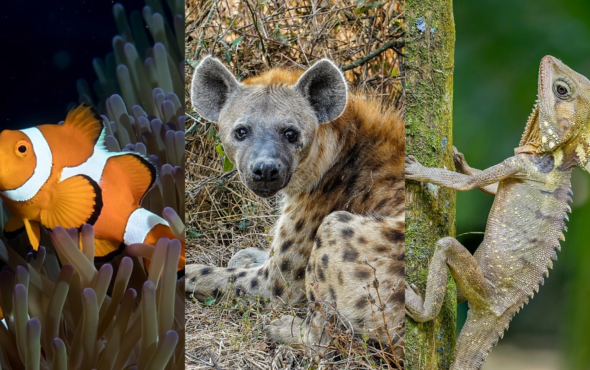
Since 1988, 1 December has been designated World AIDS Day. It’s an opportunity to raise awareness, show support for people living with HIV and remember the many, many millions lost. When Madonna takes to the stage at Amsterdam’s Ziggo Dome tonight, she will mark World AIDS Day by dedicating her poignant ballad ‘Live to Tell’ to “all the bright lights” extinguished by the disease.
This moving tribute won’t be a one-off – it’s a staple of her latest live show, ‘The Celebration Tour’ – and reflects the singer’s four decades of allyship. From her 1991 documentary Truth Or Dare to her Boy Scout stunt at the 2013 GLAAD Awards, the pop legend has long stood in solidarity with the LGBTQIA+ community. Deborah Gold, chief executive of the National AIDS Trust, says that Madonna’s “support for people living with HIV and for the LGBTQ+ community has been unwavering”. It was also ahead of its time. “She wasn’t the first pop artist to embrace her LGBTQ+ following, but she was one the loudest and she was doing it when it wasn’t cool to be so inclusive,” Gold adds.
For this reason, Madonna’s performance of ‘Live to Tell’ in memory of HIV/AIDS victims has become the emotional centrepoint of The Celebration Tour since it began in London in October. Matthew Hodson, executive director of NAM aidsmap, says that both times he saw the tour, her rendition of Live to Tell “hit me like a wall collapsing on top of me”.
Within the set, the tribute begins with the song ‘Holiday’, when Madonna and her dancers party like it’s 1983 at seminal New York nightclub Paradise Garage – a place she frequented during her pre-fame days. Towards the end of the number, her dancers depart the stage, leaving just one who falls to the floor in front of her. After she covers him with a cape, we hear a few bars of ‘In This Life’, Madonna’s 1992 elegy to friends lost to AIDS, and then ‘Live to Tell’ begins.
“Madonna came to New York in 1978 and was immersed in that queer club culture, she found herself at the centre of the gay HIV/AIDS epidemic,” Hodson says. The first news story about the then-mysterious disease appeared in 1981 in the gay newspaper New York Native. In 1983, the year Madonna released her eponymous debut album, two separate research groups concluded that a novel retrovirus – what we now call HIV – may have been infecting people with the more deadly AIDS (Acquired Immunodeficiency Syndrome).
In her tour tribute, we see just how profoundly Madonna was affected by the epidemic. First, an unfolding video screen shows the face of Martin Burgoyne, her New York roommate, who died of AIDS-related complications in 1986 aged just 23. Then two more screens show Christopher Flynn, her high school ballet teacher taken in 1990, and Keith Haring, her artist friend who succumbed in the same year. All three were gay men.
As the tribute continues, these video screens are filled with the faces of dozens and dozens of other HIV/AIDS victims including Queen singer Freddie Mercury, cult actress Cookie Mueller and disco pioneer Sylvester.
It’s a deeply personal moment, from Madonna, that flowers into something universal that LGBTQIA+ fans who lost friends and lovers of their own can resonate with. “It made me look back to when my life was filled with friends dying and going to funerals while, at the same time, family members and [straight] people were going on as normal,” Hodson says. “I think Madonna was experiencing what many gay men were experiencing at the time, which was seeing their friendship circle being decimated.”
Madonna has used her profile to shine a spotlight on HIV and AIDS since she became a pop culture colossus in the mid-’80s and this crossover of activism has continued to this day. “She was certainly one of the first major global figures to speak out about [the epidemic],” Gold says. “What made her contribution so impactful was her ability to speak directly to younger people and to the LGBTQ+ community who were already fans of her music.”
In 1987, Madonna turned the final date of her Who’s That Girl World Tour into an AIDS benefit that raised $400,000 for research charity amfAR. Two years later, she included an insert titled “The Facts About AIDS” with her latest album, Like a Prayer. “People with AIDS – regardless of their sexual orientation – deserve compassion and support, not violence and bigotry,” the insert states. It also provides clear advice on how to prevent infection: “The simple act of putting on a condom can save your life, if they’re used properly and every time you have sex.”
Then in 1991, Madonna doubled down on her safer sex message by telling fans who attended her Blond Ambition World Tour: “Hey you, don’t be silly, put a rubber on your willy.” According to Gold, “Madonna used her platform to demystify conversations around safer sex”, which proved doubly important. “Not only did this help educate people, but by talking openly about HIV, she was humanising people who were experiencing huge amounts of stigma and discrimination,” Gold says. “The impact of having a superstar like Madonna speaking about you with respect and love at that time cannot be understated.”
It was also a brave move in an era when HIV and AIDS was cruelly and ignorantly stigmatised as a “gay plague”. AIDS was first recognised by the US Centers for Disease Control and Prevention (CDC) in 1981, but then-President Ronald Reagan didn’t publicly acknowledge it until 1985 or give a significant speech about the epidemic until 1987. Because Madonna did so much lobbying at a time when many other public figures were silent, rumours began to circulate that she had been diagnosed as HIV positive.
Madonna put these rumours to bed in 1991 when she received amFAR’s Award of Courage at a benefit event in Los Angeles. “Now I’m not HIV-positive, but what if I were?” Madonna said in her acceptance speech. “I would be more afraid of how society would treat me for having the disease than the actual disease itself. If this is what I have to deal with for my involvement in fighting this epidemic, then so be it.”
According to Hodson, Madonna’s refusal to be shamed for being depicted as HIV positive – albeit inaccurately – made a seismic difference at the time. “It was such a strong, uncompromising take on HIV and challenging the stigma around it,” he says. “It’s quite easy to forget how rare it was for someone to be a ‘gay ally’ back then. There were a few gay allies like Liza Minnelli, but Madonna took it to a new level because you felt that she was in the trenches fighting alongside us.”
More than 30 years later, Madonna remains fervently committed to fighting HIV and AIDS, a disease that is now easier to treat but still a major public health issue. According to the World Health Organization, an estimated 39 million people were living with HIV globally at the end of 2022. On World AIDS Day four years ago, Madonna posted a photo of her friends who were taken by the epidemic, then reminded us that it hasn’t gone away. “AIDS is still a threat. There is no cure!!!! We must find one and we must keep the memories of these senseless deaths alive forever,” she wrote in her caption.
This staunch support was celebrated last Saturday at a fundraising event organised by Madonna podcast Inside the Groove alongside the National AIDS Trust. Held at an iconic London LGBTQIA+ venue, the Royal Vauxhall Tavern, it brought in £5,000 for the charity. Gold says she wanted to take part in a panel event discussing Madonna’s HIV and AIDS advocacy work because the singer “has shown immense solidarity throughout her career and it felt right on World AIDS Day to honour that”.
In 2023, when we’re really beginning to question what it means to be an “ally” – is the odd supportive word really enough? – it’s important to acknowledge someone who has stuck her neck out for us time and time again. If anyone has earned Gay Twitter’s favourite term of endearment, “She’s Mother”, it is surely Madonna.



